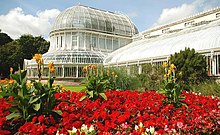

Palm house is a term sometimes used for large and high heated display greenhouses that specialise in growing palms and other tropical and subtropical plants. In Victorian Britain, several ornate glass and iron palm houses were built in botanical gardens and parks, using cast iron architecture. Especially in English-speaking countries outside the British Isles, these are often called conservatories, in the UK mainly a term for small glass structures attached to houses.

The large example, completed in 1848, in Kew Gardens, London was arguably the first greenhouse to be built on this scale.[1] It was also the first large-scale structural use of wrought iron.[2][3][4] The later Temperate House at Kew is in fact even larger. Other British examples are at Liverpool's Sefton Park and Stanley Park.[5] Elsewhere there are the Franklin Park Conservatory in Columbus, Ohio, the Royal Greenhouses of Laeken in Brussels, the Palmenhaus Schönbrunn in Vienna, and many others.
The rounded shapes of Kew were often followed in the 19th century. Parts of the iron technology there were borrowed from shipbuilding, so the resemblance of many designs to upturned ships in not entirely coincidental. In the 20th century some pyramidal designs and geodesic domes were adopted. The "Tropical Pyramid" at the Muttart Conservatory in Alberta (c. 1976) and Eden Project in England are respectively examples of these shapes. The term "palm house" tends not to be used, though the function of the buildings remains the same.
- ^ "Palm House | Kew". kew.org. Retrieved 2020-02-24.
- ^ Das Grosse Palmenhaus im Schlosspark Schönbrunn Vienna Federal Gardens. (in German)
- ^ "Zimmerpalmen" (in German). Archived from the original on November 6, 2016. Retrieved November 5, 2016.
- ^ Palmenhaus Schönbrunn – Revitalisation Waagner-Biro.
- ^ "Palm House and Rose Garden". Royal Botanic Gardens, Kew. Retrieved 19 October 2014.
